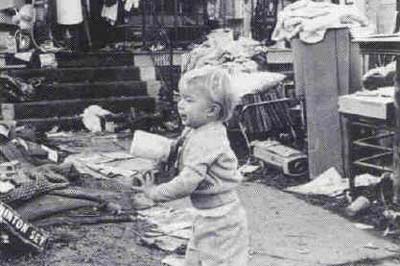Roanoke, Virginia 1985. Disasters can leave a lasting impact on families and children. |
 |
As you begin to understand your flood risk, you will learn what steps your community has taken to reduce flooding risks. Learn more of what you should know about flood risk.
The term 100-year flood plain is often misunderstood. If you live in this area, what it really means is that you have a better than 25% chance you will experience flooding during a 30 year period of mortgage payments.
One of the most important things you can do to better understand flood risk is to GET INVOLVED.
Floods that extend beyond the 100-year flood plain will occur. Flooding can occur along rivers and streams with no formal flood plain map under the National Flood Insurance Program.
Over time flood plains change. Development upstream can change current hydraulic and hydrologic runoff patterns and impact downstream flooding. As such much damage occurs outside of mapped floodplains.
Everyone is at risk. These animated scenarios demonstrate how various factors impact different neighborhoods and help you understand your chances of experiencing a flood.
Different flood scenaries include flooding from snow melt, flash floods, new development, dams and levees, and tropical storms. Floods are the most common natural disaster in the U.S.
Know your different flood risks.
Congress mandated federally regulated or insured lenders to require flood insurance on properties that are located in areas at high risk of flooding.
FloodSmart.gov can help you find the insurance requirements for your flood risk area and help you determine which area your property is in.Flood zones are a commonly used term in floodplain management. FEMA provides a definition of a flood zone and guidance for managing floodplain development through the National Flood Insurance Program.
The National Flood Insurance Program (NFIP) Policy Index is a compendium of floodplain management regulations, policies, technical buletins, and guidance which the user navigates by key word.
Your flood risk isn't just based on history: it's based on many factors that include current weather patterns, natural changes in the environment, and recent development in your community.
In high-risk areas, there is at least a 1 in 4 chance of flooding during a 30-year mortgage. In moderate- to low-risk areas, the risk of flooding is reduced but not completely removed. These areas submit more than 20 percent of National Flood Insurance Program claims and receive one-third of Federal disaster assistance for flooding. Areas of undetermined risk still have the possibility of flooding but the risk isn't certain or has not been studied.
The 1-percent annual chance flood is the basis for the National Flood Insurance Program the probability is thought to be a fair balance between protecting the public and overly stringent regulation. The 1-percent annual chance flood is an elevation that has a 1 in 100 chance of being equaled or exceeded in any 1 year, and it has an average recurrence interval of 100 years, so it often is referred to as the "100-year flood". However, a better way of looking at the "100-year flood" is that is has a 1 in 100 chance of happening each year or a 1 in 4 chance of happening in 30 years. For more information about the "100-year flood", visit the following sites:
Flooding has an impact on us personally, emotionally and financially. Insurance can help repair and replace some things but things with sentimental value are often irreplacable.
The cost of flooding increases depending upon the depth of the water in the home. An online simulation demonstrates the financial impact of a flood.
The FloodSmart Video Series from FEMA FloodSmart demonstrates the best way to understand the consequences of flooding. Many similar videos can be found on YouTube for regional areas.
Understanding the impacts of flooding to your home, farm, business or other property will help you determine the best course of action to plan ahead for flooding.
Federal and state agencies provide a number of programs and authorities to assist communities in better understanding and responding to their communities flood risk.
Different flood scenaries include flooding from snow melt, flash floods, new development, dams and levees, and tropical storms. Floods are the most commen natural disaster in the U.S.
Roanoke, Virginia 1985. Disasters can leave a lasting impact on families and children. |
 |